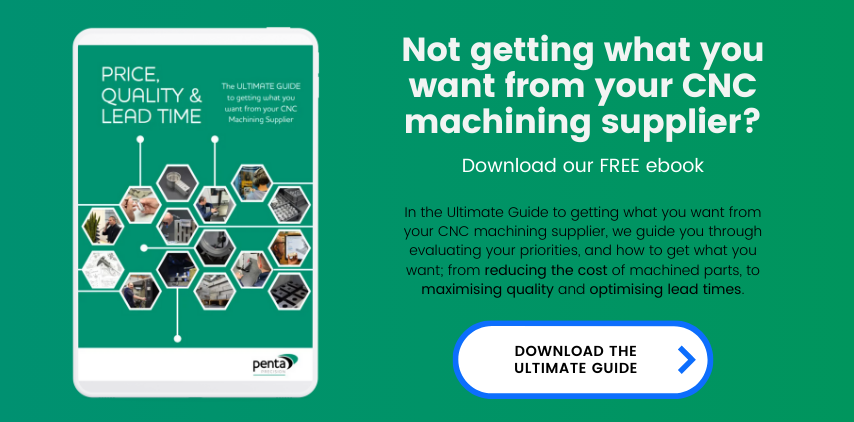 by David Ruffle
by David Ruffle
Are you ready to bring your product design to fruition? Perhaps you’ve researched manufacturing options and have come across CNC milling?
If so, you might have encountered the options of 3-axis, 4-axis and 5-axis milling. These terms refer to the different directions in which a cutting tool can move, with different machines offering varying capabilities.
As the Milling Team Leader here at Penta Precision, I’m well aware of the incredible capabilities of CNC milling as a manufacturing method.
So what are the differences between these three types of milling and what are the advantages and disadvantages of each? Let’s dive in…
3-axis milling
3-axis milling is the simplest form of CNC machining, where the workpiece is fixed in a single position and the spindle holding the cutting tool moves along three linear axes: X (side to side), Y (back to front) and Z (up and down). This type of CNC milling is ideal for less complex projects and is commonly used for simple profiling, drilling, slotting and contouring tasks.
Capabilities
3-axis milling is best suited for flat, 2D geometries, and simpler 3D shapes. It is less ideal for machining complex parts with intricate details or undercuts as it requires the orientation of the workpiece for different sides.
Advantages
For more simplistic machining requirements, 3-axis milling can be cost-effective. 3-axis milling machines are typically more straightforward to program and operate and run times can be quick for single fixture setups, often making shorter lead times possible.
Disadvantages
3-axis milling is often only suitable for simpler geometries. Multiple setups are required for multi-sided parts which can be time-consuming and less efficient.
4-axis milling
4-axis milling builds upon the capabilities of 3-axis milling by adding a rotational axis. This fourth axis (often referred to as the A-axis) allows the workpiece to rotate, providing access to additional sides and angles without needing to reposition the part manually.
Capabilities
4-axis milling is suitable for parts requiring holes or features on multiple sides, more intricate shapes and complex geometries. However, it still can’t match the complexity achievable with 5-axis milling.
Advantages
Improved efficiency can be gained by reducing the need for multiple setups where appropriate. 4-axis milling can also handle parts with rotational symmetry more effectively.
Disadvantages
A 4-axis machine is typically more costly than a 3-axis one and may require an engineer with additional skills and experience to carry out more advanced programming.
5-axis milling
5-axis milling represents the pinnacle of CNC machining technology, with the ability to move the cutting tool along five different axes simultaneously.
There are the basic three axes that are a commonality in all CNC milling (X, Y and Z) plus an additional two axes.
The fourth axis sees a rotation around the X-axis and the fifth axis rotates around the Z-axis.
Some types of 5-axis machines see the fourth axis rotate around the Y-axis instead of X. The difference between the two types is that the rotation occurs either by the workpiece or by the spindle.
There are also two types of 5-axis CNC mills. There is a 3+2 (i.e. 3 axes plus 2 axes) and there is a fully continuous 5-axis mill. In 3+2, the two rotational axes operate independently of each other. Whereas in fully continuous 5-axis, the two rotation axes can simultaneously rotate at the same time as the X, Y and Z axes.
Capabilities
5-axis milling is ideal for highly complex and intricate parts including aerospace components, medical devices and complex prototypes.
Advantages
Expect unmatched flexibility and capability for complex geometries. 5-axis milling can machine intricate details and undercuts in a single setup. It is also capable of higher accuracy and surface finish due to fewer setups and by eliminating the need for repositioning.
Disadvantages
5-axis mills are unsurprisingly an expensive bit of kit as is their maintenance. They also require advanced programming skills and more setup time. Thus, 5-axis milling should only be used where the part requires it.
Choosing the right axis
If at this point, you’re wondering how you decide between them, the good news is that this isn’t your call to make.
An established CNC machining company will have all 3 types of machines and a team of programmers, setters and operators with varying experience and expertise to run them.
Your CNC machining company should then decide how best to allocate a part to which team/machine based on:
- Part complexity: simple parts with straightforward geometries can be efficiently handled by 3-axis milling. As complexity increases, 4-axis and 5-axis milling become more advantageous.
- Precision requirements: higher axis milling (i.e. 4 and 5-axis) offers superior precision and surface finish
- Production volume: for prototypes and small batches, the flexibility of 5-axis milling can be beneficial despite the higher cost. For higher-volume production, the setup efficiency of 4-axis (or even 3-axis for some simple components) might be preferable.
- Cost considerations: budgetary considerations often play a significant role. While 5-axis milling offers the most capabilities, it also comes with higher costs. Weighing the benefits against the costs is essential.
Conclusion
3-axis, 4-axis and 5-axis CNC milling each comes with advantages and disadvantages. The key here isn’t for you to pin down which method is most appropriate before contacting prospective CNC machining companies.
The secret is finding a CNC machining company that will ask the right questions, importantly listen to the answers and identify the most appropriate milling method for your project.
Our customer service team at Penta is fantastic because they take the time to ask these questions at the quoting stage. So when you get a quote from Penta, you know that it’s based on accurate information rather than guesswork. Once you place your order, the legwork has already been done and the production team can get straight to scheduling your component in on the machines.
If you like the sound of our way of working and would like a no-obligation chat about your project, please do give us a call on 023 9266 8334 or email .
